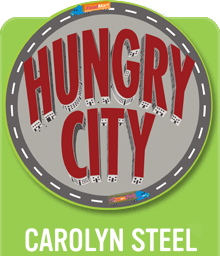The London Festival of Architecture
Mea Culpa. I have been a very remiss blogger of late. My only excuse is that things have been a bit hectic recently, and I’m not used to it. I know that’s a bit like saying ‘the dog ate my homework’, but there it is. I’m not used to blogging either. But I am trying to do better.
I did want to say a word or two about the talk I gave at the LFA last week, because it was a thrilling moment for me in many ways. It was my first ever public lecture, and it took place in a building – the Coin Street Neighbourhood Centre, by Haworth Tompkins – that is testimony to what can be achieved when people say ‘no’ to the forces of Mammon. A subject very close to my heart, and one that is a consistent thread through Hungry City.
In short, Coin Street, like Covent Garden (which I deal with in the book) is one of the most successful modern urban developments in London, yet would not exist were it not for a bunch of dedicated locals having kicked up a fuss when their neighbourhood was due to be bulldozed and turned into a faceless office precinct. I know I am summarising a complex socio-political problem in a few clichéd phrases, but I hope you get the picture. Cities NEED these nuggets of resistance: these knotty, belligerent, don’t-play-the-game, sod-you passionate pockets of identity that distinguish one place from another, provide the grit that allows the urban crystal to thrive.
So it felt great to be in Coin Street to talk about ‘How Food has Shaped London’, the subject of my talk. Even greater to be there with the fabulous Sheila Dillon in the chair (my dream come true) and such a fantastic panel of respondents, among them Arthur Potts-Dawson, a truly inspirational chef who was the ‘backroom boy’ in Jamie Oliver’s first Fifteen restaurant and has since set up two of his own – Acorn House and Water House – which between them have created an entirely new and vital category of eatery: the eco-restaurant. (I could go on, but won’t for now: Arthur deserves an entire post of his own). My other two respondents were equally august: the architect Sarah Wigglesworth MBE, who runs a pioneering practice from her equally pioneering ‘straw-bale’ house in London; and George Nicholson, who might in this context be described as the ‘missing link’, since he was instrumental both in the reinvention of Borough Market and the Coin Street development.
To be standing in such a room, with such a chair and panel, in front of such an audience, talking about food and cities, felt extraordinary. Perhaps I can be forgiven for not blogging more now. These are amazing times, and I find it hard not to gush.











July 23rd, 2008 at 1:03 pm
Lovely to to see so many posts! I plan to ‘listen again’ to your lecture online…thanks for the reminder – meanwhile,
thought I’d pass on a little story:
I often go to the local BP/Marks and Spencer food shop to buy a for a few late-night supper provisions.
When I get to the check-out the staff always asks, “Any petrol?”
Having arrived on foot or bicycle in every case, I point to my groceries and say, “This is MY fuel.”
Most of the time, my claim elicits a little pause, then a smile of recognition. Sometimes, however, the checker doesn’t understand my point and asks again, “Any petrol?”
July 23rd, 2008 at 11:52 pm
Hi Martha,
Love the anecdote – and of course you’re right: food is energy, as the bio-fuel debate is making very clear.